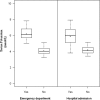Validity of the International Classification of Diseases 10th revision code for hyperkalaemia in elderly patients at presentation to an emergency department and at hospital admission
- PMID: 23274674
- PMCID: PMC4399109
- DOI: 10.1136/bmjopen-2012-002011
Validity of the International Classification of Diseases 10th revision code for hyperkalaemia in elderly patients at presentation to an emergency department and at hospital admission
Abstract
Objectives: Evaluate the validity of the International Classification of Diseases, 10th revision (ICD-10) code for hyperkalaemia (E87.5) in two settings: at presentation to an emergency department and at hospital admission.
Design: Population-based validation study.
Setting: 12 hospitals in Southwestern Ontario, Canada, from 2003 to 2010.
Participants: Elderly patients with serum potassium values at presentation to an emergency department (n=64 579) and at hospital admission (n=64 497).
Primary outcome: Sensitivity, specificity, positive-predictive value and negative-predictive value. Serum potassium values in patients with and without a hyperkalaemia code (code positive and code negative, respectively).
Results: The sensitivity of the best-performing ICD-10 coding algorithm for hyperkalaemia (defined by serum potassium >5.5 mmol/l) was 14.1% (95% CI 12.5% to 15.9%) at presentation to an emergency department and 14.6% (95% CI 13.3% to 16.1%) at hospital admission. Both specificities were greater than 99%. In the two settings, the positive-predictive values were 83.2% (95% CI 78.4% to 87.1%) and 62.0% (95% CI 57.9% to 66.0%), while the negative-predictive values were 97.8% (95% CI 97.6% to 97.9%) and 96.9% (95% CI 96.8% to 97.1%). In patients who were code positive for hyperkalaemia, median (IQR) serum potassium values were 6.1 (5.7 to 6.8) mmol/l at presentation to an emergency department and 6.0 (5.1 to 6.7) mmol/l at hospital admission. For code-negative patients median (IQR) serum potassium values were 4.0 (3.7 to 4.4) mmol/l and 4.1 (3.8 to 4.5) mmol/l in each of the two settings, respectively.
Conclusions: Patients with hospital encounters who were ICD-10 E87.5 hyperkalaemia code positive and negative had distinct higher and lower serum potassium values, respectively. However, due to very low sensitivity, the incidence of hyperkalaemia is underestimated.
Figures

Similar articles
-
Validity of the International Classification of Diseases 10th revision code for hospitalisation with hyponatraemia in elderly patients.BMJ Open. 2012 Dec 28;2(6):e001727. doi: 10.1136/bmjopen-2012-001727. Print 2012. BMJ Open. 2012. PMID: 23274673 Free PMC article.
-
Validity of the International Classification of Diseases, Tenth Revision code for acute kidney injury in elderly patients at presentation to the emergency department and at hospital admission.BMJ Open. 2012 Nov 29;2(6):e001821. doi: 10.1136/bmjopen-2012-001821. Print 2012. BMJ Open. 2012. PMID: 23204077 Free PMC article.
-
Validation of an International Statistical Classification of Diseases and Related Health Problems 10th Revision Coding Algorithm for Hospital Encounters with Hypoglycemia.Can J Diabetes. 2017 Jun;41(3):322-328. doi: 10.1016/j.jcjd.2016.11.003. Epub 2017 Mar 3. Can J Diabetes. 2017. PMID: 28268189
-
Temporal Trends and Predictors of Thirty-Day Readmissions and Emergency Department Visits Following Total Knee Arthroplasty in Ontario Between 2003 and 2016.J Arthroplasty. 2020 Feb;35(2):364-370. doi: 10.1016/j.arth.2019.09.015. Epub 2019 Sep 14. J Arthroplasty. 2020. PMID: 31732370 Review.
-
Emergency department factors associated with survival after sudden cardiac arrest.Resuscitation. 2013 Mar;84(3):292-7. doi: 10.1016/j.resuscitation.2012.10.013. Epub 2012 Oct 24. Resuscitation. 2013. PMID: 23103887 Review.
Cited by
-
Predicting hypoglycemia after treatment of hyperkalemia with insulin and glucose (Glu-K60 score).BMC Emerg Med. 2022 Nov 12;22(1):179. doi: 10.1186/s12873-022-00748-9. BMC Emerg Med. 2022. PMID: 36371171 Free PMC article.
-
Evaluation of safety, effectiveness and treatment patterns of sodium zirconium cyclosilicate in management of hyperkalaemia in China: a real-world study protocol.BMJ Open. 2023 Mar 8;13(3):e070530. doi: 10.1136/bmjopen-2022-070530. BMJ Open. 2023. PMID: 36889826 Free PMC article.
-
Updates in hyperkalemia: Outcomes and therapeutic strategies.Rev Endocr Metab Disord. 2017 Mar;18(1):41-47. doi: 10.1007/s11154-016-9384-x. Rev Endocr Metab Disord. 2017. PMID: 27600582 Free PMC article. Review.
-
Treatment of Mild Hyperkalemia in Hospitalized Patients: An Unnecessary Practice?Can J Hosp Pharm. 2021 Summer;74(3):269-276. doi: 10.4212/cjhp.v74i3.3154. Epub 2021 Jul 1. Can J Hosp Pharm. 2021. PMID: 34248167 Free PMC article.
-
Incidence of and risk factors for newly diagnosed hyperkalemia after hospital discharge in non-dialysis-dependent CKD patients treated with RAS inhibitors.PLoS One. 2017 Sep 6;12(9):e0184402. doi: 10.1371/journal.pone.0184402. eCollection 2017. PLoS One. 2017. PMID: 28877239 Free PMC article.
References
-
- Elixhauser A, Steiner C, Harris RD, et al. Comorbidity measures for use with administrative data. Med Care 1998;36:8–27. - PubMed
-
- Schaefer TJ, Wolford RW. Disorders of potassium. Emerg Med Clin N Am 2005;23:723–47. - PubMed
-
- Palmer BF. Managing hyperkalemia caused by inhibitors of the renin-angiotensin-aldosterone system. N Engl J Med 2004;351:585–92. - PubMed
-
- Reardon LC, Macpherson DS. Hyperkalemia in outpatients using angiotensin-converting enzyme inhibitors. Arch Intern Med 1998;158:26–32. - PubMed
LinkOut - more resources
Full Text Sources
Medical
